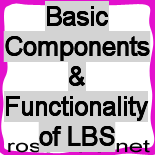Basic Components & Functionality of LBS
Mobile Device: Consists of basic electronic instruments like mobile phone, smart phone, laptop and other personal digital devices (PDA) for accessing information. User can obtain information in form of voice, text, graphs, picture etc. Devices can be for different purposes; specific and multi purpose.
Some devices are used only for any specific purposes like the vehicle tracking device offering passive or real-time navigation information of the vehicle. Also the system contains emergency messaging option that vehicle operator can send instantly to the operation system for any kind of assistance.
Whereas multipurpose devices such as mobile phones, smart phone, pocket PC, Laptop or other PDA devices that can be used for different purposes in our day to day life. However, multipurpose devices are small in size with small display unit, computing and small memory storage unit thereby limiting information calculation option. So these devices require service stations that can calculate and send results to the user.
Communication Network: In LBS communication network generally represents the wireless mobile network that serves as a two-way communication provider. This first collects the data sent by the user; transfer it to the service station and then sent back the requested information to the user mobile unit. It also determines the exact location of the user.
Mobile network is also classified into different categories on the basis of the range, purpose, and limitation of radio waves and geological features.
- Wireless Wide Area Networks (WWAN) covers from 100m to 35 km and user requires license for use. This consists of the Global System for Mobile (GSM), General Packet Radio Service (GPRS) and Universal Mobile Telecommunication System (UMTS). GSM and GPRS can carry a data up to a maximum of 14 and 115 kbps respectively whereas UMTS can transfer data up to 2 Mbps.
- Wireless Local Area Networks (WLAN) covers a distance between 10 to 150 m but it becomes a little higher up to 250 to 300 m incase of outdoors. Mobile stations comes under this network can connect with each other through access points.
- Wireless Personal Area Networks (WPAN) is used for short-range connectivity covering an area of around 10m and the frequency system requires no license. Generally consists of Bluetooth and Infrared (IrDA) devices that works along with WWAN and WLAN and so the WPAN is called an adhoc network. Data transfer capacity for Bluetooth technology is 1Mbps within a range of 10m and in case of Infrared (IrDA), it is around 16 Mbps in a maximum range of 1.5 m.
Positioning Components: The most important thing in conducting the mobile service is the user’s position, which can be obtained with the help of Global Positioning System or the mobile communication network including radio stations. In case of GPS the position can be determined automatically with the help of tracking software that detects the device position by calculating the signals of satellites (triangulation method). In some case the user has to manually calculate the position of the device in respect to the known base station’s positions.
Mobile Service Provider: Some of the common services that a service provider offers are hardware and software, data content, wireless network and infrastructure, handset, etc. These are required for different purposes like measuring the geographic position, setting up a route, traffic information, finding a particular place etc. Again different service provider and operators offers various other services according to the user’s requirements.
Content and data providers present data including general yellow pages, topography, road information and some specific landmarks such as hospital, hotel, restaurant, airport, railway station etc.



